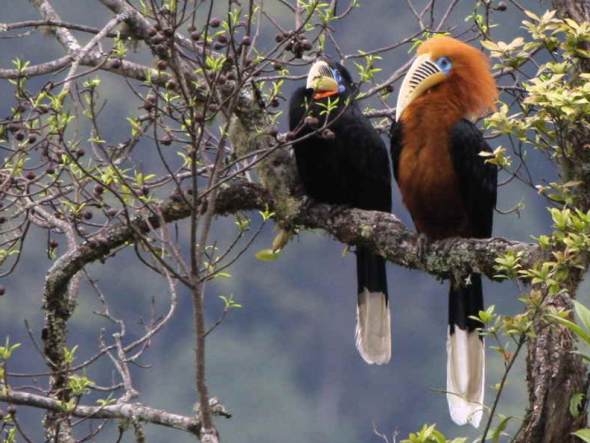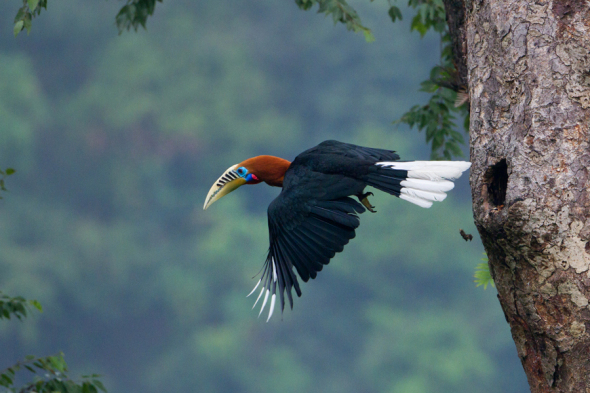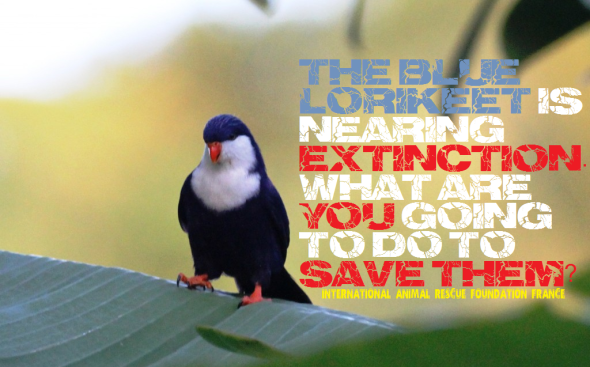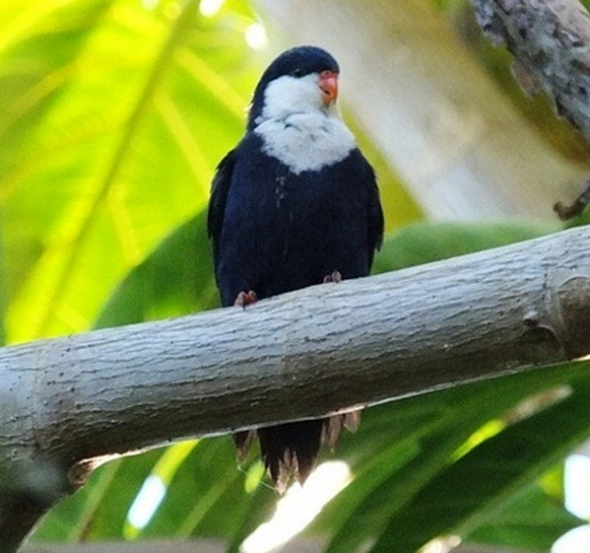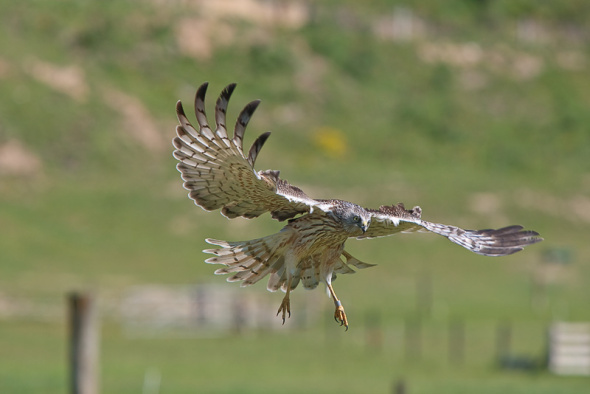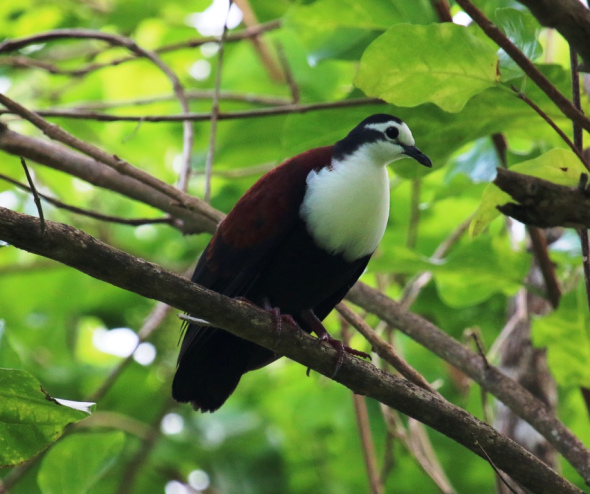Endangered Species Monday | Heteroglaux blewitti - Extinction is now Imminent.
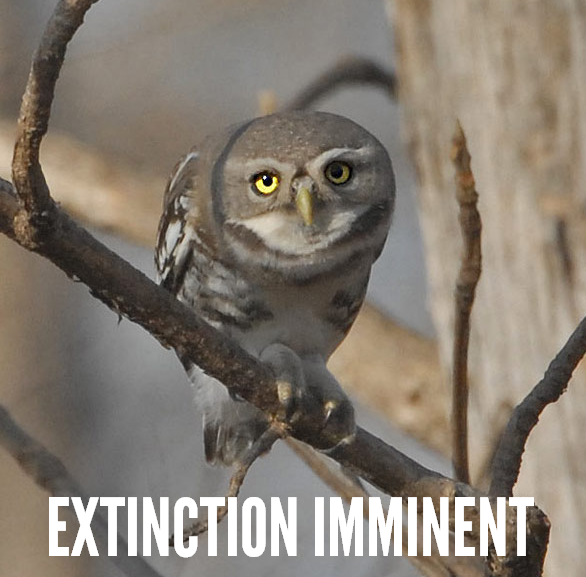
Endangered Species Monday | Heteroglaux blewitti - Extinction is now Imminent
This Mondays (ESP) article (Endangered Species Article), I am am documenting yet again on a species of forest owl (being the third time). This time I know for sure the species is going to go extinct - and sadly there is little that can be done to preserve the bird, although environmentalists are still battling, unfortunately it’s not looking good at all. (Image Credit: Birds of the Bible for Kids).
Listed as (critically endangered), the species was identified back in 1873 by Dr Allan Octavian Hume CB (6 June 1829 – 31 July 1912) was a civil servant, political reformer, ornithologist and botanist who worked in British India. He was one of the founders of the Indian National Congress, a political party that was later to lead in the Indian independence movement. A notable ornithologist, Dr Hume has been called “the Father of Indian Ornithology” and, by those who found him dogmatic, “the Pope of Indian ornithology.”
As an administrator of Etawah, he saw the Indian Rebellion of 1857 as a result of misgovernance and made great efforts to improve the lives of the common people. The district of Etawah was among the first to be returned to normalcy and over the next few years Dr Hume’s reforms led to the district being considered a model of development. Dr Hume rose in the ranks of the Indian Civil Service but like his father Joseph Hume, the radical MP, he was bold and outspoken in questioning British policies in India.
He rose in 1871 to the position of secretary to the Department of Revenue, Agriculture, and Commerce under Lord Mayo. His criticism of Lord Lytton however led to his removal from the Secretariat in 1879. Back in 1988 the Forest Spotted Owlet was listed by environmentalists as threatened. Unfortunately since the 1980’s habitat destruction, poaching, deforestation and gradual human population increases have skyrocketed.
“CONTRADICTIONS”
Conservationists allegedly from 1994-2012 battled hard to preserve the species of Spotted Owlet, regrettably their battles have been lost. Back in 2013 a further census was undertaken of which proved the species was nearing complete extinction within the wild. Today (2016) its incredibly likely we’ll lose the Spotted Owlet from all of its range.
Endemic only to India there is estimated to be (from the last census of 2013) a depressing total of 50-260 mature individuals remaining. The total number of “sub-populations has been identified as 2-100. Furthermore within the past ten years from 2006-2016 there has a been “ALLEGEDLY” a continuous population decrease of exactly 10%-19%. International Animal Rescue Foundation India has also reported within the past four years that “very small populations known are still decreasing”, and from records kept the species is highly likely to be extinct within the next 730 days, which is exactly two years.
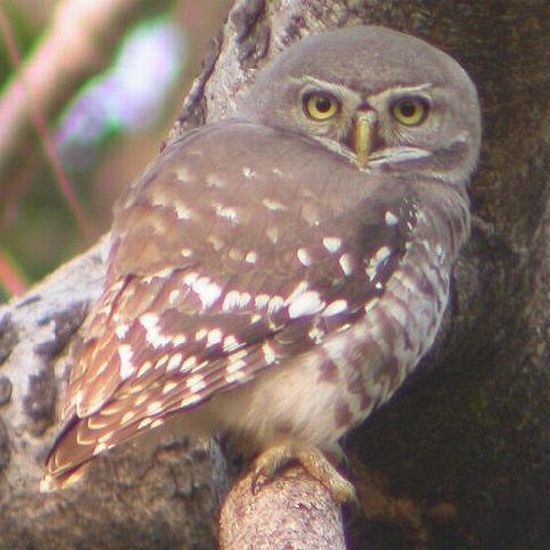
Image credit: Ashley Banwell / World Birders
The International Union for the Conservation of Nature RED LIST have ‘deliberately lied’ and ‘misinformed the general public’ stating the the bird listed hereto was extant from the years of 1988-1996. Conservationists from International Animal Rescue Foundation India in New Delhi hasn’t no reports from 1988-1996 because the bird was only re-discovered in 1997 after it was described in 1873, and it was not seen after 1884 and considered extinct until it was rediscovered 113 years later in 1997 by Pamela Rasmussen. Source: Ripley, S. D. (1976). “Reconsideration of Athene blewitti (Hume).”. J. Bombay Nat. Hist. Soc. 73: 1–4.
So whatever the IUCN are talking about is either codswallop or deliberate misinformation to garner further donations from the public?. I mean how on earth can one make this absurd lie up? Maybe the IUCN can produce documented evidence that proves the species has been active from the 1980’s to 1997? I highly doubt that they can, furthermore this lie (among many more) also brings into question any other lies the organisation “may have been publishing within the public domain” to misinform the general public?
Moving on - the population is estimated (as explained) to number 50-249 mature individuals based on the number of records from known sites, with c. 100 individuals now recorded from Melghat Tiger Reserve. This estimate is equivalent to 75-374 individuals in total, rounded here to 70-400 individuals. Given the increasing number of records and sites known within its range it may prove to be more common than previous evidence has suggested.
Trend Justification: The species faces a number of threats which in combination are suspected to be causing a decline at a rate of 10-19% over ten years.
THREATS
Listed on CITES APPENDIX I (The highest listing) meaning all hunting, poaching and any trade of this species is strictly forbidden (unless otherwise stated). Given its rarity, identification of threats is difficult. Forest in its range is being lost and degraded by illegal tree cutting for firewood and timber, and encroachment for cultivation, grazing and settlements, as well as forest fires and minor irrigation dams.
The site of its initial discovery in 1872 (Chhattisgarh) has completely been encroached by agriculture. Large areas of forest in the Yawal Wildlife Sanctuary and Yawal Forest Division as well as the Aner Wildlife Sanctuary and the Satpuda mountain ranges in Maharashtra have recently been subject to encroachment leading to habitat loss for this species.
It is likely that other forest areas where it occurs are under similarly intense pressure. Overgrazing by cattle may reduce habitat suitability. The proposed Upper Tapi Irrigation Project threatens 244 ha of prime habitat used by the species. It suffers predation from a number of native raptors, limiting productivity, and it faces competition for a limited number of nesting cavities.
The species is hunted by local people and body parts and eggs are used for local customs, such as the making of drums. Pesticides and rodenticides are used to an unknown degree within its range and may pose an additional threat.
These owls typically hunt from perches where they sit still and wait for prey. When perched they flick their tails from side to side rapidly and more excitedly when prey is being chased. It was observed in one study that nearly 60% of prey were lizards (including skinks), 15% rodents, 2% birds and the remaining invertebrates and frogs. When nesting the male hunted and fed the female at nest and the young were fed by the female.
The young fledge after 30–32 days. The peak courtship season is in January to February during which time they are very responsive to call playback with a mixture of song and territorial calls. They appear to be strongly diurnal although not very active after 10 AM, often hunting during daytime. On cold winter mornings they bask on the tops of tall trees. Filial cannibalism by males has been observed.
Thank you for reading.
Dr Jose Carlos Depre - PhD. MEnvSc. BSc(Hons) Botany, PhD(NeuroSci) D.V.M.
Environmental, Botanical & Human Scientist.
www.speakupforthevoiceless.org
Endangered Species Friday: Aceros nipalensis
Endangered Species Friday: Aceros nipalensis
This Fridays (ESP) - Endangered Species watch Post I have chosen to document on this stunning species known commonly as the Rufous-cheeked Hornbill, because of large population declines throughout most of the birds historical range. More awareness needs to be created with regards to this particular bird specie due to their natural habitat declining and localized extinctions that have already occurred in the past decade. Furthermore extinctions are now likely to occur within Viet Nam and [west] Thiland where hunting is the primary threat to the species.. (Image credit Ian Fulton).
Identified back in 1829 by Mr Brian Houghton Hodgson (1 February 1800 or more likely 1801– 23 May 1894) was a pioneer naturalist and ethnologist working in India and Nepal where he was a British Resident. He described numerous species of birds and mammals from the Himalayas, and several birds were named after him by others such as Edward Blyth.
Listed as vulnerable the A. nipalensis is endemic to Bhutan; China; India; Lao People’s Democratic Republic; Myanmar; Thailand and Viet Nam. Unfortunately A. nipalensis has already been declared extinct locally in Nepal. Like many large birds within this region of Asia the Rufous-cheeked (or necked) Hornbill’s populations are declining quite extensively throughout their range of which deforestation and habitat degradation and, hunting is primarily to blame.
The species has been listed on Cites Appendix (I-II) of which an estimated population census count has determined there are no less than 2,500 birds but no greater than 9,999. A survey count back in 2001 by Bird-Life International concluded that from the [estimate] above the [true] population count is actually by far more lower than previously suggested, however few conservationists are now debating this due to the birds ‘alleged’ extensive range within South East Asia.
From the Bird Life International (2001) census the organisation stated there was no fewer than 1,667 mature individuals but no greater than 6,666, which is rounded to 1,500 to 7,000 mature individuals exactly. Since the last 2001 census its quite possible populations have increased and decreased to date.
A. nipalensis is known to inhabit the following ranges; Bhutan, north-east India, Myanmar, southern Yunnan and south-east Tibet, China, [west] Thailand, Laos and Viet Nam. The species has declined [drastically] and is no longer common throughout most of its known historical range. While we know the species is now regionally extinct within Nepal the next likely localized extinction may very well be within Viet Nam of which its populations have fallen to alarming rates.
Within [most] of Thailand where the species was quite common reports have sadly indicated the bird is no longer commonly seen, and like Viet Nam, Thailand could become the third county to see localized extinctions occurring too, the only known habitat within Thailand that A nipalensis occurs now is within west Thailand. To date reports have confirmed that within Bhutan A. nipalensis remains pretty much common of which Bhutan is known to the birds [largest] stronghold.
Healthy large populations have also been documented back in 2007 within Namdapha National Park, India, Nakai-Nam Theun National Biodiversity Conservation Area, central Laos and perhaps also Huai Kha Khaeng, [west Thailand], and Xishuangbanna Nature Reserve, China. Some conservationists have been led to believe that while populations are considered quite large within these strongholds that the species may very well be “more widespread than previously thought”. Meanwhile the species is known to inhabit north Myanmar, and there are recent records from West Bengal and Eaglenest Wildlife Sanctuary, Arunachal Pradesh, India.
Rufous-cheeked Hornbill commonly resides within broad-leaved forest, some reports have also indicated the species to be present within dry woodland too. Mating and nesting normally occurs from the months of March to June within large wide girth trees, the very trees that the species depends on though are being felled throughout most of the Hornbills historical range.
Image: Rufous-necked-Hornbill (Photographer unknown)
Major Threats
Its dependence on large trees for feeding and nesting makes it especially susceptible to deforestation and habitat degradation through logging, shifting cultivation and clearance for agriculture. Furthermore, viable populations require vast tracts of forest to survive, exacerbating its susceptibility to habitat fragmentation. These problems are compounded by widespread hunting and trapping for food, and trade in pets and casques. Hunting is the primary threat to the species in Arunachal, India. A report from the Wildlife Extra organisation details poaching incidents with regards to Hornbills.
Wildlife Extra stated:
The unique and intriguing breeding habits that caught Pilai Poonswad attention are central to the birds’ plight. Each hornbill pair seeks out a suitable hollow – 15 to 40 metres above the ground in the trunk or branch of a Neobalanocarpus, Dipterocarpus or Syzygium tree – in which to raise a single chick. When a suitable cavity is found, the female walls herself in, using mud supplied by her mate and regurgitated food, to hatch and rear her chick. The male feeds them for the next three months and, if he fails, both mother and chick may perish. The birds consume up to 80 different kinds of fruit, scattering the seeds over many hectares of forest. With other seed-distributing animals such as monkeys now scarce, the hornbill has become pivotal in maintaining the integrity of the forest. But the birds rarely spread the seeds of the trees in which they nest: if these disappear, the hornbills too will vanish – and the trees and plants they help propagate will soon follow.
Click the link above via the [report] to read more on this very fascinating conservationist.
My name is Dr Jose Carlos Depre, MD, B.Env.Sc, BSBio, D.V.M. I myself have been working within bird, tree kangaroo and pachydermata conservation, rescue and reporting for over fifteen years.
Within these unique, wonderful and exhilarating years I have witnessed one of my favorite species of animals [birds] declining to worrying levels that is now so concerning it has led to sleepless nights for many years. Should we continue to see such catastrophic population decreases of birds we’ll eventually witness alarming declines of plants and trees. The same applies with insects and herbivorous mammals too.
Like insects birds are incredibly important for both human and animal survival. The vast majority of all bird species rely on plants for their staple diet. On consuming fruits, leaves, flowers Etc, the very seeds within the birds diet of life needed to continue seed dispersal will be lost should all bird populations go extinct. Should this occur we selfish humans will then become the Planets seed disperses. Think about that next time you fell a tree or rip a plant up.
Dr Jose. C. Depre
Environmental and Botanical Scientist.
Thank you for reading and please share fare and wide to create as much awareness for all Hornbills as possible.
Endangered Species Monday: Vini peruviana.
Endangered Species Monday: Vini peruviana
This Monday’s endangered species watch post (ESP) I document on a rather elusive bird that is rarely spoken about within the conservation theater or among animal rights organisations. Listed as (vulnerable) the species was formally identified by Professor Philipp Ludwig Statius Müller (April 25, 1725 – January 5, 1776) was a German zoologist. (Image V. peruviana, photographer Tara)
Statius Müller was born in Esens, and was a professor of natural science at Erlangen. Between 1773 and 1776, he published a German translation of Professor Linnaeus’s Natursystem. The supplement in 1776 contained the first scientific classification for a number of species, including the dugong, guanaco, potto, tricolored heron, umbrella cockatoo, red-vented cockatoo, and the enigmatic hoatzin. He was also an entomologist.
Despite the birds high population size the Blue Lorikeet-scientifically named as Vini peruviana is under threat from feral cats, accidental introduction of black rats and violent storms that hit the birds native range frequently causing untold damage and catastrophic destruction to the specie habitat. Furthermore the ‘swamp harrier’ remains an all out threat to Blue Lorikeet’s range which has led to wide range species decline. Swamp Harriers predate on the Blue Parikeet mainly due to the birds color.
Endemic to the Cook Islands and French Polynesia, Blue Lorikeet population sizes are declining quite fast of which drastic conservation measures are now required to control feral cats and the accidental introduction of black rats, not forgetting measures to either reduce swamp harriers or introduce a non-endangered prey for the harrier. The last survey which I believe was undertaken sometime back in 2012 showed a ‘global population’ estimated to be at 7,200 to 9,000 individuals. Which is still quite high, however not high enough to stop the species qualifying for the classification of (endangered).
Taking into consideration range and overall total population size (at an estimate) the species falls into the ‘band’ of 2,500 to 9,000 individuals. This equates (exactly) to 1,677-6,666 ‘mature individuals’ rounded to 1,500-7,000 mature individuals. Summarizing; the exact total population size could be as low as 1,500 but no greater than 7,000 mature individuals (which is extremely concerning).
Blue Lorikeet’s have been recorded within twenty of the south-east Polynesia islands, unfortunately on seven of these islands the species has since been declared officially extinct. The species now remains sparsely distributed on some thirteen islands of which is threatened by rats, feral cats and the swamp harrier. We now know the species is situated within the Society Islands (formerly all), the northern atolls of the Tuamotu Archipelago (both French Polynesia), and Aitutaki (Cook Islands).
Image: Blue Lorikeet - Vini peruviana
Within the Society Islands conservation teams estimated that there were some 200-400 individual pairs on the Motu One and Manuae respectively in 1973 , however this may no longer be the case. On the Maupihaa island back in 1999 conservationists that believed the species to be extinct located breeding pairs. In Tuamotus 2006 surveys have shown the following data in relation to population sizes; Kaukura (1,000), Rangiroa (1,000), Arutua (500), Apataki (200) and Tikehau (50).
Meanwhile in Tiamanu Motu in Apataki atoll a minimum 300 individuals were estimated back in 1989 (this sub-population being allegedly smaller than 10 years previously). On Aitutaki, where it was probably introduced, numbers have been estimated at under 500 pairs, 2,400 individuals and 1,000 individuals (2006).
Following the devastation of Cyclone Pat (2010) a further census was undertaken to asses the impacts of freak weather patterns and catastrophic cyclones on the species. Distance sampling surveys on the island of Aitutaki (2011) showed a decrease in population size of exactly 1,400 individuals. That’s quite a substantial decline of individuals caused directly by a single yet destructive cyclone.
Blue Lorikeets depend on coconut palms for nesting and some of its food, and will frequent cultivated areas. They also roost in palm trees, rising at dawn and calling and preening before feeding. They are usually found in small flocks of less than ten birds. They are active birds, feeding on nectar, insects, and ground forage.
Image: Swamp Harrier (Wiki) - . Circus approximans
Threats
The species’s extinction from many islands is most likely due to predation by black rat Rattus rattus and to a lesser extent, feral cats Felis catus. Blue Lorikeet’s have gone extinct from Makatea in the Tuamotus could have been accelerated by a particularly violent hurricane. Its range reduction in the Society Islands correlates with the spread of the introduced Swamp Harrier Circus approximans. The accidental introduction of black rats to the islands where Blue Loirkeet persists is a continuing threat to the species. Listed on Cites Appendix II conservation actions are under way with more projects proposed.
Thank you for reading.
Dr Jose. C. Depre
Botanical and Environmental Scientist.

